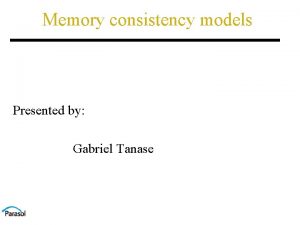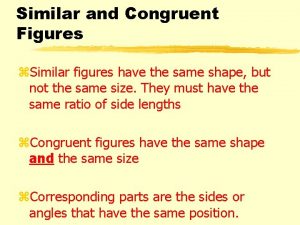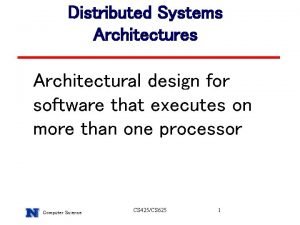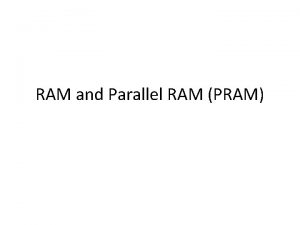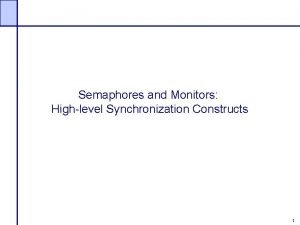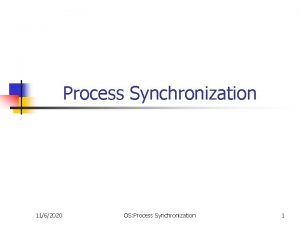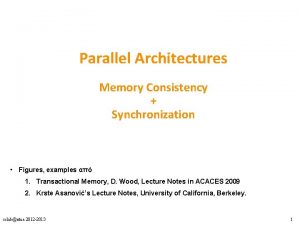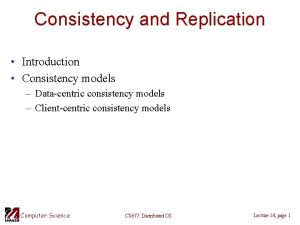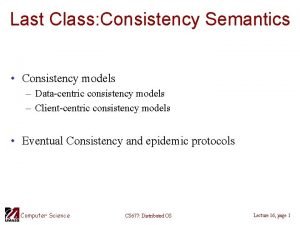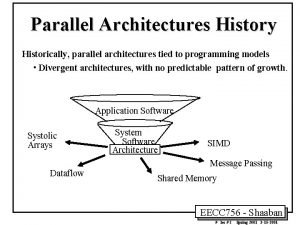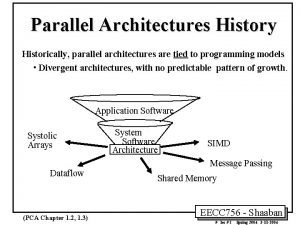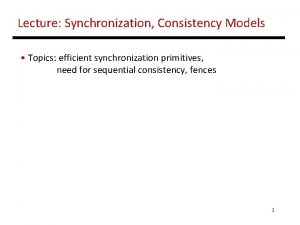Parallel Architectures Memory Consistency Synchronization Figures examples 1














































- Slides: 46

Parallel Architectures Memory Consistency + Synchronization • Figures, examples από 1. Transactional Memory, D. Wood, Lecture Notes in ACACES 2009 2. Krste Asanović’s Lecture Notes, University of California, Berkeley. cslab@ntua 2014 -2015 1




Παράδειγμα 2 Producer posting Item x: Load Rtail, (tail) Store (Rtail), x Rtail=Rtail+1 Store (tail), Rtail Το πρόγραμμα είναι γραμμένο με την υπόθεση ότι οι εντολές εκτελούνται σε σειρά. cslab@ntua 2014 -2015 Consumer: Load Rhead, (head) spin: Load Rtail, (tail) if Rhead==Rtail goto spin Load R, (Rhead) Rhead=Rhead+1 Store (head), Rhead consume(R)

Παράδειγμα 2 (2) Producer posting Item x: 1 2 Load Rtail, (tail) Store (Rtail), x Rtail=Rtail+1 Store (tail), Rtail Ο tail pointer μπορεί να ανανεωθεί πριν την εγγραφή του x! Consumer: Load Rhead, (head) spin: Load Rtail, (tail) 3 if Rhead==Rtail goto spin Load R, (Rhead) 4 Rhead=Rhead+1 Store (head), Rhead consume(R) § Ο προγραμματιστής υποθέτει ότι αν η 3 πραγματοποιηθεί μετά τη 2, τότε η 4 πραγματοποιείται μετά την 1. § Προβληματικές ακολουθίες: o 2, 3, 4, 1 o 4, 1, 2, 3 cslab@ntua 2014 -2015




Sequential Consistency § “A multiprocessor is sequentially consistent if the result of any execution is the same as if the operations of all the processors were executed in some sequential order, and the operations of each individual processor occur in this sequence in the order specified by its program. ” [Lamport, 1979] § SC = τυχαία μίξη των (εν σειρά) αναφορών των σειριακών προγραμμάτων στους επεξεργαστές cslab@ntua 2014 -2015










Παράδειγμα : Relaxed Consistency με Fences Producer posting Item x: Load Rtail, (tail) Store (Rtail), x Fence. SS Rtail=Rtail+1 Store (tail), Rtail εγγυάται ότι ο tail pointer δε θα ανανεωθεί πριν την εγγραφή του x cslab@ntua 2014 -2015 Consumer: Load Rhead, (head) spin: Load Rtail, (tail) if Rhead==Rtail goto spin Fence. LL Load R, (Rhead) εγγυάται ότι ο R δε Rhead=Rhead+1 θα φορτωθεί πριν Store (head), Rhead την εγγραφή του x consume(R)






Weak Ordering vs Release Consistency WO cslab@ntua 2014 -2015 RC

Παράδειγμα: Sparc V 9 memory fences § #Load § #Store. Load § #Load. Store § #Store § Logical or-ed combinations possible § #XY = “All X operations that appear before the memory fence in program order complete before any Y operations that follow after the memory fence in program order. ” § (+) Ευελιξία όσον αφορά την βέλτιστη εκμετάλλευση του εκάστοτε relaxed consistency model για μέγιστη απόδοση § (-) Προγραμματιστικά δύσκολη + ζητήματα μεταφερσιμότητας ανάμεσα σε διαφορετικά models cslab@ntua 2014 -2015







Παράδειγμα : Αμοιβαίος Αποκλεισμός Thread 1 xdatap data Thread 2 xdatap Memory ld xdata, (xdatap) add xdata, 1 sd xdata, (xdatap) Τι χρειάζεται για να εκτελεστεί σωστά ο κώδικας; cslab@ntua 2014 -2015

Αμοιβαίος Αποκλεισμός με Load/Store (1) § Χρήση 2 διαμοιραζόμενων μεταβλητών. c 1 = 1; L: if c 2 = 1 then go to L; <critical section> c 1 = 0; Πρόβλημα; cslab@ntua 2014 -2015 → Deadlock! c 2 = 1; L: if c 1 = 1 then go to L; <critical section> c 2 = 0;



Peterson (1981) vs Dekker (1966) Peterson's: "I want to enter. " "You can enter next. " "If you want to enter and it's your turn I'll wait. " Else: Enter CS! "I don't want to enter any more. " flag[0]=true; turn=1; while(flag[1]==true&&turn==1){ } // CS flag[0]=false; Dekker's: "I want to enter. " "If you want to enter and if it's your turn I don't want to enter any more. " "If it's your turn I'll wait. " "I want to enter. " Enter CS! "You can enter next. " "I don't want to enter any more. " flag[0]=true; while(flag[1]==true){ if(turn!=0){ flag[0]=false; while(turn!=0){ } flag[0]=true; } } // CS turn=1; flag[0]=false; Πηγή: http: //cs. stackexchange. com/questions/12621/contrasting-peterson-s-and-dekker-s-algorithms cslab@ntua 2014 -2015 38








 Replicated data consistency explained through baseball
Replicated data consistency explained through baseball Shared memory in unix
Shared memory in unix Shared memory consistency models: a tutorial
Shared memory consistency models: a tutorial Intel processor
Intel processor Sequential consistency
Sequential consistency All similar figures are congruent
All similar figures are congruent Whats a plane figure
Whats a plane figure Solid and plane figures
Solid and plane figures Types of product architecture
Types of product architecture Database storage architecture
Database storage architecture Ansi/sparc
Ansi/sparc Backbone network components
Backbone network components Autoencoders, unsupervised learning, and deep architectures
Autoencoders, unsupervised learning, and deep architectures Scalable internet architectures
Scalable internet architectures Integral vs modular architecture
Integral vs modular architecture Gui architectures
Gui architectures Database system architectures
Database system architectures Cdn architectures
Cdn architectures Aaron bannert
Aaron bannert Three tier architecture of data warehouse
Three tier architecture of data warehouse Define instruction set
Define instruction set Ecommerce server
Ecommerce server Banking system architecture diagram
Banking system architecture diagram Backbone network architectures
Backbone network architectures Cache coherence for gpu architectures
Cache coherence for gpu architectures Why systolic architectures
Why systolic architectures Resultant of two parallel forces
Resultant of two parallel forces Semantics prototype
Semantics prototype Explicit memory
Explicit memory Long term memory vs short term memory
Long term memory vs short term memory Internal memory and external memory
Internal memory and external memory Primary memory and secondary memory
Primary memory and secondary memory Logical versus physical address space
Logical versus physical address space Which memory is the actual working memory?
Which memory is the actual working memory? Page fault
Page fault Virtual memory in memory hierarchy consists of
Virtual memory in memory hierarchy consists of Eidetic memory vs iconic memory
Eidetic memory vs iconic memory Shared vs distributed memory
Shared vs distributed memory Pram ram
Pram ram Fast clock to slow clock synchronization
Fast clock to slow clock synchronization One fundamental high level synchronization construct is
One fundamental high level synchronization construct is Process synchronization in os
Process synchronization in os Data synchronization in tally
Data synchronization in tally Multiprocessor synchronization
Multiprocessor synchronization What is lean synchronization
What is lean synchronization Show bgp neighbor
Show bgp neighbor Lock free synchronization
Lock free synchronization




